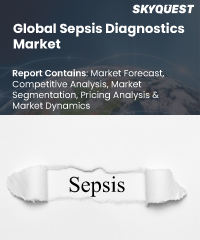
Product ID: SQMIG35A2237

Report ID:
SQMIG35A2237 |
Region:
Global |
Published Date: March, 2024
Pages:
219
|
Tables:
59 |
Figures:
75
Drivers
Rising incidence of hospital-acquired infections
The increasing occurrence of hospital-acquired infections (HAIs), commonly referred to as nosocomial infections, represents a significant global health concern. Among the most prevalent HAIs are urinary tract infections, pneumonia, and sepsis. These infections can have particularly severe consequences in vulnerable patient populations, including those who are immunocompromised, elderly, or suffering from chronic illnesses. In the United States, there is a troubling trend of rising sepsis incidence among hospitalized patients, with an annual increase of 8.7%. It is estimated that the United States witnesses over 1,000,000 cases of sepsis among hospitalized patients each year, as reported by the Centers for Disease Control and Prevention (CDC) in 2018. Given the rapid escalation of HAIs on a global scale, there is a heightened demand anticipated for sepsis diagnostic products in the years ahead.
Development of rapid diagnostic/POC techniques for early sepsis diagnosis
The early diagnosis of sepsis presents a considerable challenge, as even a delay of just one minute in administering antibiotics to septic shock patients with hypertension can result in a 7.6% increase in mortality risk. Consequently, there is a growing imperative for the swift and accurate diagnosis of sepsis to minimize delays in antibiotic therapy for affected patients. Many manufacturers specializing in sepsis diagnostics are actively expanding their product portfolios to incorporate point-of-care (POC) technologies designed to rapidly detect sepsis, thereby reducing the overall time required for diagnosis. One such example is the BD Company (US), which offers automated microbial detection systems including the BACTEC Plus, BacT/Alert, and BACTEC FX blood culturing instruments. These instruments are engineered to facilitate the swift diagnosis of sepsis, with a turnaround time as short as three hours. This development represents a significant advancement in sepsis diagnosis, aligning with the critical need for rapid intervention in septic patients.
Improvement in Awareness in Emerging Countries to Boost Diagnostic Procedures
The growing prevalence of sepsis represents a significant economic and healthcare challenge, particularly in developing nations. To address this issue, various government and non-government entities are actively engaged in initiatives aimed at enhancing public awareness of this condition. These programs typically encompass activities such as sepsis screening, educational campaigns, evaluation of sepsis bundle performance, the adoption of advanced diagnostic techniques to improve patient outcomes, and the establishment of treatment protocols. An illustrative example can be found in an article published by Springer Nature Switzerland AG in October 2021, highlighting that the implementation of such programs and guidelines contributes to increased adherence to sepsis bundles and a reduction in mortality rates among affected patients. One of the notable organizations leading in this endeavor is the Global Sepsis Alliance, which has forged partnerships with various entities across different regions, including Latin America and Africa, to raise awareness about sepsis. Additionally, the World Health Organization (WHO) has collaborated with 52 countries to execute the Global Maternal Sepsis Study and Campaign (GLOSS), which seeks to assess the prevalence and management of maternal sepsis while also enhancing healthcare workers' awareness of this critical issue. Consequently, the collective efforts of government organizations and foundations to foster awareness and garner support are expected to significantly bolster the global market for sepsis diagnostics.
Restraints
High cost associated with the development and commercialization
One of the major restraints of the global sepsis diagnostic market is the high cost associated with the development and commercialization of advanced diagnostic solutions. Additionally, the lack of awareness among the general population about sepsis and its symptoms can hinder the market growth. Moreover, the lack of healthcare infrastructure in developing countries can limit the availability of sepsis diagnostic solutions, which can hinder market growth. Finally, the stringent regulatory framework governing the approval of diagnostic solutions can also be a challenge for manufacturers operating in the market.
Our industry expert will work with you to provide you with customized data in a short amount of time.
REQUEST FREE CUSTOMIZATIONWant to customize this report? This report can be personalized according to your needs. Our analysts and industry experts will work directly with you to understand your requirements and provide you with customized data in a short amount of time. We offer $1000 worth of FREE customization at the time of purchase.

Product ID: SQMIG35A2237